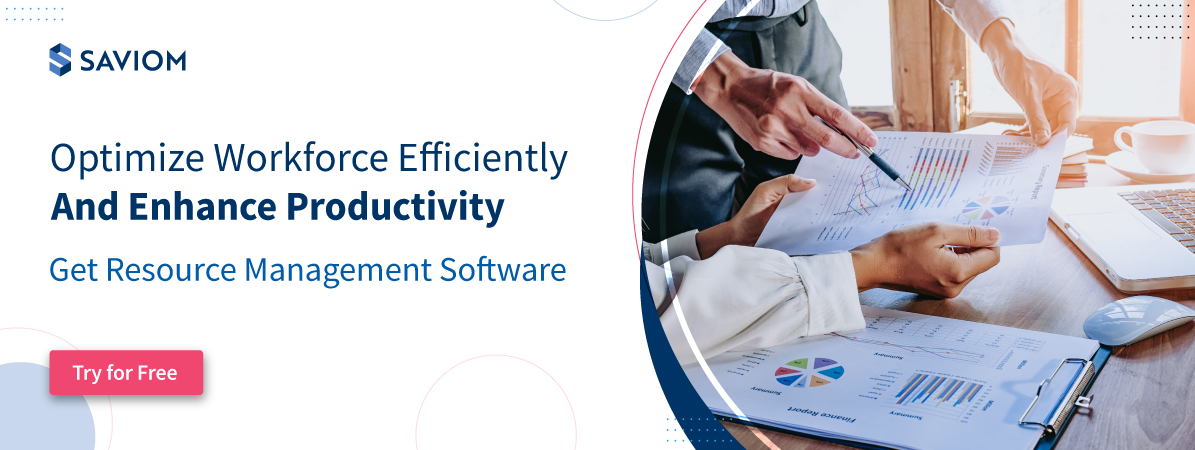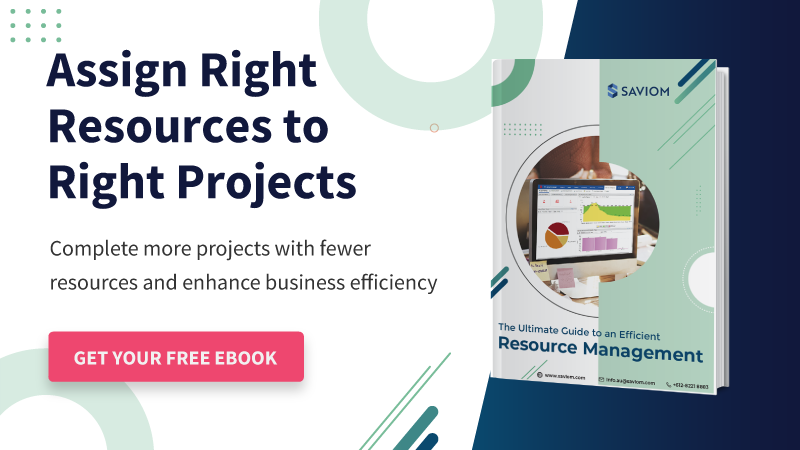Whether you are a project or a resource manager, your primary concern would be ensuring the productivity of your project team or the workforce within your span of control.
However, there may be situations where even your most experienced and skilled resources fail to produce desired outcomes. This low productivity and performance can be attributed to multiple factors such as low motivation, excessive workload, etc.
As a manager, you will implement various measures to ensure that resources work to their full potential so that the project is on track. These strategies can be conducting feedback meetings, holding motivational or stress management sessions, and so on.
However, in addition to these, another effective and more practical tactic one can deploy is workforce optimization which ensures that the employees spend most of their time in billable or strategic activities.
This blog shall cover the essentials of optimizing employees’ schedules and enhancing their productivity.
But first, let’s understand what the term means.
What is workforce optimization?
Workforce optimization can be considered as a business strategy or a management practice used to enhance the productivity, efficiency, and performance of the employees. The ultimate goal of workforce optimization is to leverage the employees’ potential to the maximum extent and improve business profitability.
In the project and resource management landscape, it comprises planning, forecasting, allocating, scheduling, and optimizing utilization of the organizational resources. It is done in two different stages, which are:
- The resource manager’s level and
- The project manager’s level.
To better understand the nitty-gritty of this concept, let’s consider there are two projects in the pipeline. One is an external billable software development project, and the other is an internal non-billable but strategic product-upgradation project.
The first question is – which project will be given precedence? Next, where will the resources be allocated first? These questions are addressed after meticulous strategic thinking at the resource manager’s level.
The following section explains how the project is selected and how resource managers allocate the resources.
Read More: How Resource Optimization Boosts Task Management?
Workforce optimization at resource manager’s level
Here is a rundown of the steps that the resource manager follows for optimizing the workforce:
Prioritizing projects before allocating resources
Continuing with the previous example, after getting the resource requests for both projects, the resource manager will first analyze them. As the software development project is billable, it will generate revenue and enhance profitability. On the other hand, because the product-upgradation project is strategic, it can be taken up gradually, keeping the long-term goal in mind. However, the billable one will require immediate attention since the client’s expectations are riding with it, and it will also have a specific deadline. If delivered successfully, it would enhance profitability, customer satisfaction, and brand reputation.
Given the end result and returns, the resource manager prioritizes the software development project. Following this, he/she starts with the resource deployment process.
Out-rotating resources from less profitable projects to strategic or profitable ones
Following the selection of the project and understanding its requirements, the resource manager will analyze the existing resource pool and identify the competencies. Then they can look at the availability and utilization of the shortlisted candidates. Managers can implement a resource management tool to get these insights on a centralized platform.
However, if the resource manager finds that the available capacity for the project is less than the demand, they can analyze the schedules of those resources currently working on other projects. For example, suppose a few critical resources with matching skill sets are working on a low-priority project. Then, the resource manager can negotiate with the project managers, out-rotate them from ongoing activities and allocate them to the new project. Moreover, they can backfill the positions with similar skilled resources to keep the projects going.
Implementing resourcing measures to bridge the shortage/excess of resources
Soon after mobilizing critical resources to the high-priority project, the resource manager will analyze the remaining resource demand to understand and assess the gap. If there is a shortage of resources, then the resource manager can undertake specific resourcing treatments such as hiring new resources, training and upskilling benched resources, etc.
Otherwise, if there is an excess of resources, the resource manager may communicate with the project manager and the key stakeholders and bring forward some projects. These measures can help the resource manager ensure that there is no gap in demand and capacity and every resource is utilized to a maximum extent.
Allocating competent resources to the suitable projects at the right time
After bridging the demand gap, the resource manager can propose the short-listed resources to the project manager. If the project manager approves the resources, then he/she can book them for the software development project.
On the contrary, if the project manager does not accept some of the proposed resources, then the resource manager can continue the search until the project manager is content with the suggested resource pool. Following this, he/she can allocate the resources to the project.
At the same time, the resources denied by the project manager can be allocated to other strategic projects or training/development programs depending on the requirements, to ensure their utilization. Following these steps, a resource manager ascertains that every resource is productive and utilized up to its potential.
These steps consolidate the workforce optimization process from the resource manager’s end. After this, the onus lies on project managers to optimize their team’s schedules and maximize productivity.
The following section will cover the same information,
Read More: Resource Allocation: A Guide on How to Apply it to Project Management
Workforce optimization at the project manager’s level
Workforce optimization is a continuous process, and every position has to take appropriate measures to achieve it. The previous section highlighted the role of a resource manager in this regard.
Similarly, the project manager also follows similar methods as described below:
Ensuring the uniform distribution of workload
In the first step, the project manager will schedule the allocated resources for the specific project tasks. While doing so, they must ensure that none of the resources are under/overloaded with the work against their capacity. For instance, if the project manager finds that certain resources have a high workload, then he/she can implement resource leveling/smoothing techniques.
If the timeline is flexible, the project manager may adopt leveling methods and adjust the project’s duration as per the resources’ schedules, to prevent overutilization. Otherwise, if the timeline is rigid, they can go for the smoothing technique and adjust their schedule by re-prioritizing and keeping the float or slack tasks for later. And if that is not possible, they can bring in more resources to support the task execution.
One critical factor that leads to over or underwork is biases from the project manager’s end. For instance, they may overload the experienced resources or whom they have worked with previously and give minimal work to others. As a result, it leads to burnout in some team members while others spend idle time due to insufficient work. That shouldn’t be the case; the project manager must ensure every team member is given fair opportunity and tapped into their maximum potential.
Improving the billable utilization of every resource
Once the scheduling is over and the project kick starts, the project manager is responsible for tracking the progress regularly. From the workforce standpoint, they will monitor the billable utilization. For this purpose, they can use a resource management solution to compare the forecasted billable utilization against the actuals. That way, the manager can measure the variance and take corrective actions as necessary.
For example, let’s consider that you are managing a project, and you forecasted 10 hours of billable work for a particular resource. But that resource ends up spending 20 hours on the task. Thus, there will be a significant variance between the two. Based on this, you can communicate with the resources and find ways to mitigate the situation. You can resolve if there are any gaps in the resource’s understanding of the task or provide additional help if required. At the same time, you can assess if the resource estimation was faulty and whether you want to procure an extra resource.
Read More: Maximize Profitable Resource Utilization with Modern Resource Management Solution
Upskilling the resource as per project’s standards
Often resources are not 100% compatible with the allocated project task. Therefore, they might require some training or upskilling to do justice and ensure the quality of the deliverable. Hence, the project manager can conduct upskilling programs for some resources before the project starts. For instance, let’s consider that the software development project requires a resource with core java skills. The resource manager allocated a resource having similar competencies but as a secondary skillset. The project manager can now conduct necessary training or upskilling programs to hone that resource’s skills and bring him/her up to the mark.
Secondly, let’s take another situation where a junior resource was allocated to the project due to the unavailability of senior resources. After some time, the project manager finds that this resource feels frustrated and finds it difficult to keep up due to the lack of required expertise. At this moment, they can negotiate with the project managers of the other projects and pull in an experienced resource who is about to get released from a project. Thus, he can allow shadowing opportunities for the under-skilled resource. These measures will help the project manager ensure that the work is completed as required and within the timeline.
Release extra resources if they are not required
There may be situations where the project manager estimated more resources than required, creating a buffer. Naturally, the resource manager also identified extra resources during fulfillment. But soon after the execution, the project manager realizes that some resources are not needed and can be released. Therefore, they can be assigned to other projects or put into training programs.
Taking the same software development project example, let’s consider that the project manager estimated ten testers. But during the testing and QA tasks, he/she realizes that only seven of them can pull off the task. Consequently, the project manager can coordinate with the concerned resource manager to release the additional members and make them available for other projects.
In conclusion, workforce optimization goes beyond managing resource schedules. It is a culmination of multiple processes that enhance resources’ productivity and performance. Additionally, it requires collective efforts from both resource and project manager’s ends.
The following section elaborates on how a resource management solution can help in workforce optimization.
Read More: Why is the Overallocation of Resources Bad for You?
How resource management software helps in workforce optimization
From the previous sections, it is evident that workforce optimization is a significant part of your job description if you are a project or a resource manager. And to assist you with that, a resource management software can be very beneficial.
We have already mentioned how an effective resource management solution can make your job easy. It can help allocate competent resources to projects, forward plan pipeline opportunities, monitor and maximize profitable utilization, reduce resourcing costs, improve resource health index, etc. In addition, using simulation and modeling techniques, the tool helps managers arrive at the best possible outcome and accordingly juggle resources across projects. Moreover, it also provides real-time business intelligence reports with actionable insights that will strengthen your decision-making process. In a nutshell, resource management software can be a game-changer in optimizing the workforce.
The final section will describe how you can optimize the workforce and improve productivity.
Tips on how to optimize your workforce
Here’s how you can optimize the workforce and improve productivity:
- Competent allocation allows resources to work on the right projects that align with their competencies and availability. Hence, they can put in their best efforts, thereby improving their productivity.
- Maximizing productive utilization enables resources to work on profitable projects. Thus, it also improves their billability and productivity since they generate revenue.
- Appropriate upskilling allows resources to hone their skills. As a result, they can improve their performance and produce better results in projects.
- Automation of mundane tasks allows resources to focus on what is essential. Consequently, it boosts efficiency.
- Considering the interests of the resource before assigning work can keep them engaged and increase productivity.
- Lastly, uniform workload distribution prevents over/underutilization and, thus, eliminates burnout. Optimal utilization improves resources’ morale, therefore, uplifting their productivity.
Conclusion
In this employee-centric era, workforce optimization plays a significant role. Apart from improving productivity, it increases accountability and sense of responsibility, reduces compliance risks, and maintains the overall resource health index.
Not just for employees, when implemented right, it also benefits the company. Successful project delivery, improved customer satisfaction, etc., are some of the benefits that the organization can avail. Besides, when your company gets known as one that values its employees, it helps boost its reputation. Thus, it also strengthens employee retention and talent attraction.
So, with all being said, what workforce optimization techniques are you following?
The Glossary
Read More: Glossary of Resource Workforce Planning, Scheduling and Management
SAVIOM Solution
SAVIOM has over 20 years of experience helping multinational clients manage their resources efficiently and effectively. With over 20 years of experience, this Australian-based MNC has a global presence across 50 countries and has helped 100+ clients meet their specific business goals. Saviom also provides tools for project portfolio management, professional service automation, and workforce planning software. So, SAVIOM can help your business to establish an efficient system geared towards your specific business challenges












